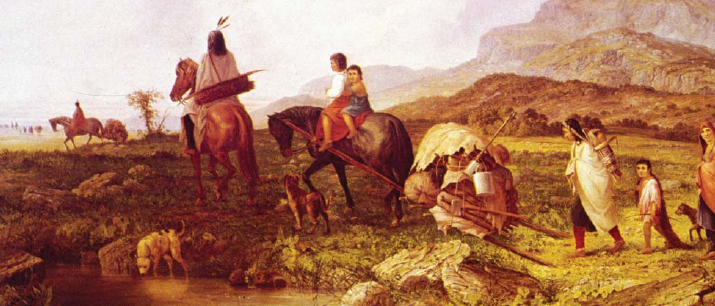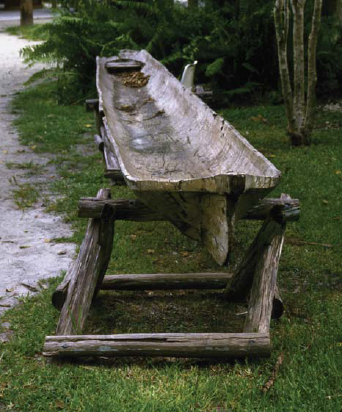
Dogs and, later, horses pulled travois, wooden frames fitted with netting for carrying supplies or sick people.
In the Northeast, hunting provided the main source of food. In the Southeastern part of the continent, farming was more important. Tribes in the Southeast planted corn, beans, tobacco, and squash in the spring. During the summer, they fished in streams and rivers. When summer cooled into fall, it was time to harvest the crops.
Men and women both worked in the fields. They used tools called mattocks. A mattock is a digging tool similar to a pick. It has a flat blade at the end at a right angle to the handle. The mattocks were made of hickory wood. Some had blades made from buffalo shoulder bones.
In addition to the planted crops, river cane grew wild along the banks of streams. Cane was used for many things, including sleeping mats, drills, arrows, shields, and building materials. It was also used in basket making.
Native Americans had many uses for baskets. They were used for storage, for washing crops, as fish and bird traps, and even as hats. Baskets were made almost everywhere in North America, using different materials in each region. Southeastern basket makers were among the best on the continent.
First, the cane would be cut into strips. Often, it was dyed. The dyes were extracted from plants in the area. Bloodroot, for example, made the cane a reddish color. Black walnut wood dyed it black, and butternut dyed it a yellowy brown.
There were two basic ways to make a basket. Some baskets were plaited. This meant that the cane was woven into a thick mesh, crossing in and out. If the cane was dyed, the basket maker could make designs in the weaving pattern. The other way to make a basket was by coiling. Strips of cane were coiled from the bottom of the basket up, in a long spiral. Some baskets were coated with resin to make them watertight.
During the summer, much of a tribe’s food came from fishing. Fishing was done from dugout canoes. Dugouts were different from birch bark canoes. They were made from hollowed-out logs.
Men hollowed the logs by slowly burning them away. In order to burn wood away, hot coals were placed on the area that needed to be removed. The coals would burn the wood beneath them slowly and evenly. When cooled, it was easy to dig the burnt wood out of the log. Indians used scraping tools called adzes made out of stone or bone. Then, more hot coals would be placed on the same area. When they cooled down, the log could be dug out even deeper.
Once the log was hollow, it was filled with heated water. This expanded the sides and softened the wood. When the dugout was as wide as it needed to be, the sides were braced with wooden crossbeams. Designs were carved on the outside. Sometimes, extra pieces were added to the front and back.
Dugouts were much heavier to carry than birch bark canoes. They also didn’t turn as quickly. Still, they were useful in catching fish. Fishermen used anchors made of stone. If water sloshed into the boat, they could bail it out using a container made from a shell. Shells were also used to make spoons, bowls, and scrapers.

Dogs and, later, horses pulled travois, wooden frames fitted with netting for carrying supplies or sick people.
Florida’s Seminole Indians made excellent dugouts. They stood in them, spearing fish and alligators in the everglades. Seminole fishermen had excellent balance. Although dugouts can tip easily, the Seminoles usually stayed upright.
When moving their camp, natives of the Plains and Southeast loaded their things onto travois. A travois is an A-shaped wooden frame, fitted over a dog’s back. Netting under the frame kept items from falling through.
By the end of the 17th century, horses—brought to America by Europeans—became more common, and bigger travois were made to fit horses. A dog could pull only 75 pounds, but a horse could pull several hundred. Travois were strong enough to carry young children and sick people. Sometimes, a travois was fitted with a shade to make the ride more comfortable.
One of the most useful resources on the Great Plains was the buffalo. Buffalo were an important source of food, of course. They also provided many things needed to make tools. Rope was made out of buffalo skin, as were shoes and clothing. Stone tips were lashed to arrows and spears with buffalo rawhide. Buffalo sinew could be made into thread. Its bones were shaped into many woodworking tools, including awls, adzes, and gouges. Intestines were made into watertight jugs. Horns were carved into ladles and spoons. In later years, horns were hollowed out and made into containers for gunpowder.

The Seminole tribes of Florida made excellent dugout canoes by hollowing out large logs with hot coals.
NATIVE AMERICAN WARFARE
North American tribal warfare was conducted mostly in quick, commando-style raids. Some tribes even carried moccasins of their enemies to disguise their tracks. Raiders stole goods and captured enemy warriors.
In some ways, Indian conflict was ceremonial. Counting coup, for example, was an important symbol of bravery. This meant touching or striking an enemy without killing him. Taking an opponent’s weapon was treated as seriously as killing him. The Blackfoot word for honor in war is namachkani. Literally, it means “a gun taken.”
When horses became common, raiding became more aggressive. War parties could move faster on horseback. Plains Indians sometimes wrapped horses’ hooves in leather to muffle the hoof beats during a sneak attack. Also, horses made a tempting target for theft.
Guns made combat deadlier, but tribal warfare had already been heading in that direction. By the 1800s, scalping was common. A scalp was the flesh and hair peeled away from the top of an enemy’s head. Scalps were dried and attached to scalp poles, weapons, or war bonnets. Sometimes, even women’s scalps were taken. They were proof that a raiding party had made it past the defending men.
On the upper Missouri River, buffalo hides were used for small, tub-shaped boats. Sioux and Mandan women crossed rivers in personal boats made from circles of hide stretched over willow frames. These bullboats were light enough for women to carry on their backs.
Another important resource was stone. Stone was essential to people all over the continent. Soft stone, such as soapstone, was used to make pipe bowls, dishes, and other containers. Harder stone, such as flint and obsidian, was chipped into shape. Craftsmen used bone chisels to chip small flakes off a rock. The chipped stone was usually quite sharp at the edges. This is how arrowheads and stone axes were made.
In the Northeast, baskets were made from cedar and sweet grass. Natives of the Southwest used rushes, yucca leaves, and willows. In the Northwest, baskets were made from cherry, spruce, and cedar bark.
Like their neighbors to the north, natives of Southeastern America and the Great Plains used bows and arrows to hunt and make war. Fighting was a constant part of life in the Southeast. In fact, the Cherokee once claimed, “We cannot live without war.” Their quivers and bow cases were decorated skins and hides stitched together.
Most men in the area wore their hair short so as not to interfere with their bowstrings. They used sharp shells to cut their hair. Some shaved their heads on one side only. Choctaw men were an exception. They wore their hair long despite their use of bows and arrows.
During early times, warriors carried large shields and long bows. They wore rawhide armor to deflect enemies’ arrows. Horseback riding changed all that. Shields and bows got smaller to make riding easier. Since swift movement was so important, warriors got rid of their bulky armor and fought wearing little clothing. Sioux warriors found a unique way to save space. They put a spear point on the upper end of their bows, which they used in hand-to-hand combat, instead of carrying a second weapon.

Native American women used the bullboat, which consisted of a buffalo hide stretched over a willow frame, to cross rivers.
Plains Indians also used composite clubs. Composite clubs have a wooden handle and a head made of something else. Many clubs were fitted with stone spikes. The stone-headed club was the main weapon on the Plains until whites brought metal. On the Northwestern Plains, the Flathead tribe used a different kind of composite club, called a pogamoggan. It had a bag attached to the head. Inside the bag was a stone, making the weapon even deadlier. §

Weirs, fence-like enclosures built across streams, trapped fish so that Native Americans could easily catch them.